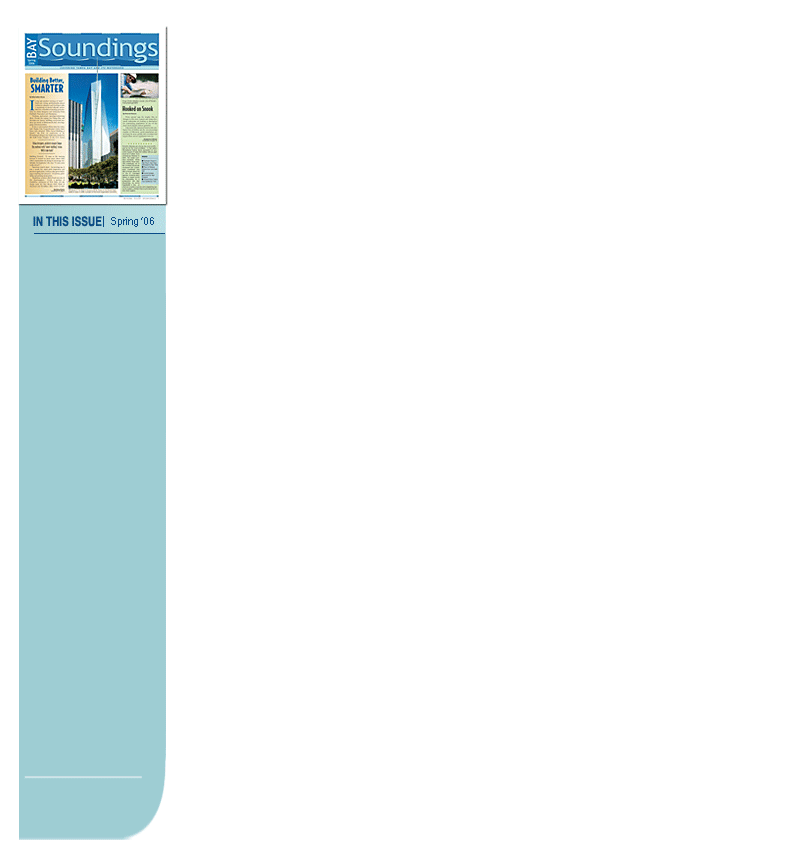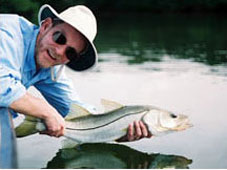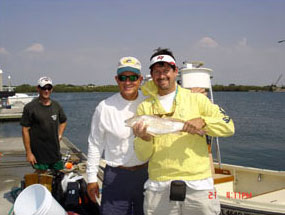

 |
||||||
 |
||||||
Hooked on Snook
By Victoria Parsons
|
Florida's Fisheries Florida’s fisheries are among the most prolific – and by far the most profitable – in the nation. Recreational fishing alone generated an economic impact of nearly $7.5 billion with an additional $1.2 billion from commercial fisheries in 2001, the latest numbers available. While each fishery faces specific challenges, six of the 13 where stocks are monitored are considered overfished and little is known about 44 of the 57 managed species. Covering each fishery in depth would be impossible for a publication like Bay Soundings, so we’ve highlighted a few of what we consider to be the more interesting topics for readers, whether they’re avid fishermen or arm-chair anglers. |
From special tags for trophy fish to changes in slot sizes, seasons and stamp fees, snook enthusiasts are looking at alternatives for maintaining populations of one of the state’s most popular inshore gamefish.
Like many fish, squeezed between the continued loss of habitat and the ever-increasing number of fishermen, snook populations are declining far more quickly than scientists had hoped when current regulations were set.
 |
|
Doug Cramer releases a snook, one of Florida’s most prized gamefish. |
While fishermen across the state generally report good catches of small snook, many are concerned about the future, particularly the scientists, guides and enthusiasts who attended Snook V, a symposium at the Florida Fish and Wildlife Research Institute earlier this year.
Sustainability in fish populations is most often measured by spawning potential ratio – or SPR, which measures the biological ability of a fishery to reproduce. The SPR for snook was set at 40 in 1994 and has been met occasionally over the years. Although somewhat lofty – the red snapper SPR is only 20 – the current snook SPR is only 26 in the Gulf and 27 in the Atlantic, and projections call for it to drop over time rather than rise.
“There ain’t no way we’re gonna get to 40 from where we are today,” quips Ron Taylor, the FWRI’s snook research expert who is also known as “Dr. Snook.”
|
The common snook, Centropomus undecimalis, is one of Florida’s most popular inshore game fish because of its spectacular fighting ability and merit as table fare. Anglers know the common snook by many names, but the two most common are robalo and linesider. The word “snook” comes from the Dutch word “snoek,” meaning pike. The majority of anglers pronounce the name as “snook” (like took), but in parts of south Florida, it is pronounced “snuke” (like fluke). |
|
Source: Florida Fish and Wildlife Research Institute, www.floridamarine.org |
With more than 90% of snook caught in Florida waters already being released, coming up with ways to boost adult populations will be particularly challenging. An ad hoc group composed of scientists, fishermen and guides was created after the symposium to take an in-depth look at options.
One particularly hot topic was a new rule that allows anglers to “pinch” the tail when measuring snook, an action which may add 3/4-inch to the length of a 26-inch snook – and potentially increase allowable harvest in the Gulf by 22% where snook are generally more numerous but smaller. “I wish we were going the other way,” said charter boat Captain Dave Marquette.
Most guides persuade clients to catch and release any snook they catch – and some have an unwritten rule of one “keeper” per boat, going so far as to move the boat if clients disagree. “I’m in the entertainment business, not the grocery business,” adds Chet Jennings of Florida Flats Fishing in Ruskin.
Other options discussed included:
Habitat a Top Priority
Snook already is managed as two populations, one Gulf, one Atlantic, with different characteristics, seasons and daily bag limits for anglers. While Atlantic snook are larger and heavier, Gulf snook are far more numerous.
The main difference is habitat — the Gulf coast has nine times the habitat and three times the fish. That habitat, however, is shrinking rapidly.
Like many fish species, larval and juvenile snook require low-salinity habitats in rivers, creeks and estuaries, but altered drainage basins have dramatically changed that habitat. “Snook can handle varying salinities but drastic changes that occur quickly – like what happens in areas where drainage basins for creeks have been altered – causes physiological stress in fish,” said Aaron Adams, staff scientist at Mote Marine Laboratory.
The result is fewer fish, and probably smaller fish. “We’re starting to dig a little deeper into growth rates and diets for juvenile snook in degraded and non-degraded creeks,” he said.
“We need to be making smarter decisions on land use,” he said. “If you look at the economic value of the west coast fisheries – snook, tarpon and redfish are worth hundreds of millions of dollars. The creek habitats are the factories that allow the fishery to continue.”
| Snook by the Numbers | |
| 2,123,695 | Snook caught on Gulf coast annually * |
| 1,251,471 | Number of snook estimated to live in the Gulf coast fishery * |
| 43,669 |
Estimate of snook that die on the Gulf coast after being caught and released (2.13% of catch) |
| 21,727 | Special snook stamps on fishing licenses in Hillsborough & Pinellas counties (respectively ranked second and third in the state) |
| 26 | Minimum length to keep, in inches |
| 34 | Maximum length to keep, in inches |
| 1 | Daily bag limit on Gulf coast |
|
* More fish than exist are caught annually because 97% of them are released to be caught again. |
|
Quota System Approved for Red Snapper
A quota system similar to that credited with saving the halibut fishery in Alaska has been approved for red snapper in the Gulf of Mexico. With minimum fanfare, the Gulf of Mexico Fishery Management Council signed off on an innovative proposal supported by commercial fishermen and environmental organizations that would set annual individual fishing quotas – or IFQs — for each commercial fisherman.
“We eliminate the derby that occurs the first 10 days of the month, and stabilize the market so that fishermen can fish when the weather is good and market demand is there,” notes Jason Rueter, a fisheries biologist with NOAA’s National Marine Fisheries Service (NMFS) in St. Petersburg. “The fishery will be as protected – if not more so — than it is now.”
Details are still to be determined but commercial fishermen will receive a share of the total allowable catch based on the type of license they hold and their historic landings. The allowable catch will be based on models that predict how much stock is necessary to rebuild a sustainable yield – expected to drop to 5 to 7 million pounds from the current limit of 9 million pounds set in 1997. Commercial fishermen will receive 51% of the total, with 49% allocated to recreational fishermen. No new restrictions are expected for recreational fishermen.
How quickly the red snapper fishery returns to sustainability is still up in the air. “We don’t have the science to be certain of the productivity of stock and how large it could become if we resolve the bycatch and overfishing issues,” said Roy Crabtree, regional administrator for NMFS. “To some extent, management has to react to how the fish respond, and new stock assessments will require new assessments of quotas.”
Bycatch Targeted Too
New measures to address bycatch – both juvenile fish and fish caught on a line but released because they don’t meet minimum size limits – are also under consideration. Recent studies indicate that up to 70% of the red snapper released by commercial fishermen die shortly afterward, Crabtree said.
“We’re hearing that commercial fishermen are throwing dead fish overboard because they’re undersized,” he said. “If we reduced the minimum size limit, they could bring in the smaller fish to count against their quota.”
 |
|
The Ethical Angler Card, available in English and Spanish from the Tampa Bay Estuary Program, features illustrations and size and daily bag limits for saltwater sportfish. |
Recreational size limits, currently 16 inches in the Gulf and 20 in the Atlantic, also may be reduced. “We had estimated mortality rates of 20% for recreational fishermen (who typically fish in shallower water than commercial fishermen) but new estimates are 15% in the eastern gulf and 40% in the western, apparently based on the depth of the water.”
Potential size limit reductions are still being discussed, but probably would not include a “slot” similar to snook that has both minimum and maximum limits.
More challenging from a technology perspective is bycatch of juvenile red snapper in shrimp nets, estimated to be more than 80% of juvenile mortality by the Coastal Conservation Association, a recreational fishing group which sued NMFS to reduce bycatch. While older snapper are typically found in reefs and hard-bottom areas, juveniles prefer sand and mud bottoms, which also are the preferred habitat for shrimp.
Shrimpers already have bycatch reduction devices on their nets but they aren’t performing as well as expected, Rueter said. “We’re looking at certifying several new bycatch reduction devises that will eliminate finfish bycatch.”
For more information, visit www.nmfs.noaa.gov.
Dramatic Drops in Red Drum, Sea Trout Attributed to Red Tide
Anybody who was anywhere near a beach last year knows that red tide killed large numbers of fish. The long-term impact, however, is still being evaluated by scientists, anglers and divers.
Preliminary data from the FMRI indicates that damage may be more species-specific than originally expected, with red drum and spotted sea trout populations taking significant hits, according to Luiz Barbieri, head of marine fisheries research.
While the full report won’t be completed until later this summer, early data from FWRI’s ongoing monitoring efforts for inshore juvenile populations indicate that red drum and sea trout numbers may have dropped as much as 50%. Other fisheries, including snook and sheepshead, appear to be in better shape although many adults were wiped out when red tide swept through their spawning aggregates.
Cause-and-effect also is still being determined, but populations of red drum and trout appear to be near normal in Charlotte Harbor, where red tide outbreaks were not as severe during the critical spawning season, Barbieri said.
Measuring the effect of red tide is more complicated than most people realize, he adds. “People think we should have crews on beaches to count dead fish, but research shows that this kind of count is not effective unless it’s a very small area and short-term damage.”
With the 2005 red tide covering much of the Gulf coast for much of the year, damage would have been impossible to assess. “We’d need people on every beach every day, and then we’d need a way to know if we’d counted each fish yesterday or not – plus we have no way of knowing what the predators and scavengers had eaten.”
The random sampling of inshore waters, formally known fisheries independent studies, has been ongoing in Tampa Bay since 1988 so scientists have an enormous database they can use to compare current data against. “We’re still going through the data but we know some species have been significantly impacted because a lot of adults were wiped out.”
Catch and Release:
Plan to Release Before Line Gets Wet
Size, weight, bag and seasonal limits are a central theme in restoring almost every fishery, from snook and tarpon to red snapper and grouper. The catch – pun intended – is that fish don’t always know they’re too small or out of season before they hit a tempting treat on a hook.
Depending on the fishery, studies at the FMRI indicate that anywhere from 2 to 70% of fish released die shortly afterward, from injuries, stress or predators who take advantage of its exhausted state. Even a small mortality rate adds up quickly. Only about 2.13% of snook die after having been released, but that works out to about 54,300 fish statewide and 35% of total harvest. Mortality rates are much higher for snapper, grouper and other reef fish, ranging up to 70% on commercial boats that typically fish in deeper water than recreational anglers.
Releasing a fish – after it has swallowed a hook, been dragged up from the depths or survived a long fight on underweight tackle – is most likely to be successful when anglers plan for release even before their lines get wet.
Closed Zone Yields Few Additional Fish
It’s just common sense. Close an area to fishing and the fish population will skyrocket.
Not so – or at least not in one area of Tampa Bay where researchers compared fishing success at Weedon Island to fishing in the 1000-foot security zone surrounding MacDill Air Force Base where access is restricted. “We’re still compiling the numbers so any report is preliminary but we’re only seeing slight differences,” said Ted Switzer, an associate research scientist with the FMRI. “There’s no striking contrast, like three or four times the number of fish at MacDill. They both have pretty good habitat and we’re not seeing incredible recruitment into either area.”
In fact, based on that preliminary data, there are probably more fish at Weedon, but they’re easier to catch at MacDill where fish aren’t as leery because they don’t see as many anglers.
 |
|
Left (background) to right, FWRI biologist Brent Winner, charter Capt. Bill Miller and Jeff Gruendel, participants in a the MacDill-Weedon Island fishing study, a cooperative effort that included charter fishermen as well as scientists. |
The study, funded through the WMFS - Cooperative Research Program, wasn’t as apple-to-apple as researchers had originally hoped, adds Bob Heagey, marine research associate at FWRI. “There is some fishing pressure at MacDill while Weedon is very heavily fished but Weedon is slightly deeper and has much more edge effect.”
Still, scientists jumped at the opportunity to compare fishing in relatively similar habitats with dramatically different human impact. “They’re doing some work in California where they study fisheries in advance of sanctuaries being closed, but that’s difficult to do,” Switzer said. “This is probably as good as we’re going to get in Tampa Bay.”
One issue that may impact the study was the relatively small size of the MacDill security zone, Heagey added. Other sanctuaries, in places like Alaska and Australia, may stretch for hundreds of thousands of acres so that fish populations are more clearly separated.
When complete later this summer, the data will compare catches per hour made by a variety of fishermen including guides, their parties and biologists fishing at specific times, sites and tides. The study also included tagging more than 2,000 fish caught in the two areas. “From what we’re seeing, they’re not moving far,” Heagey said.
Anglers who catch tagged fish are asked to call FWRI at 800-404-FWCC with information about the fish, its size and where it was caught.
Fisheries Update: Hooked on Snook, Drops in Red Drum
Profile: Artist Diane Peebles & Researcher Ernst Peebles
Ports Prepare for Heavy Weather
How to Become a Change Agent: Lessons in Social Marketing
Biomimicry: Borrowing Ideas from Nature
Local Photographers Help Celebrate Estuary Program's 15th Anniversary
Special Insert: Pinellas County Summer Camps & Special Events